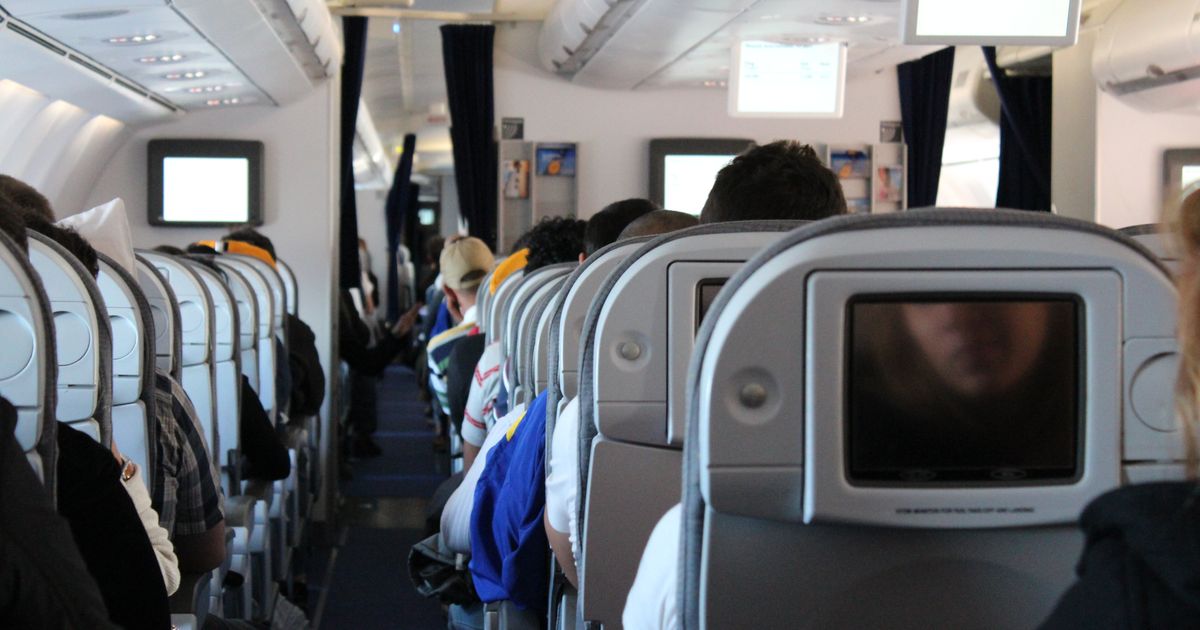Over the years, there’s been much ado in the air travel world about the etiquette of reclining your seat into the space of the passenger behind you. Is this an inherently rude act? When is it acceptable? What’s the best way to approach the recline?
But amid all this fuss, there’s an overlooked area of plane etiquette: the seat in front of you and how you interact with it throughout the flight.
“When traveling by plane, it’s important to be mindful of the seat in front of you,” etiquette coach Jamila Musayeva told HuffPost. “The space on an airplane is shared and can be quite limited, so we must all make an effort to be considerate of others.”
Courtesy and mindfulness go a long way in these uncomfortable conditions.
“Those seats are pretty thin, so just keep in mind that the person in front of you is going to feel absolutely everything,” said Nick Leighton, an etiquette expert and co-host of the “Were You Raised by Wolves?” podcast. “Being on an airplane is a team sport and we’re all in this together.”
The tray table is not a substitute for a regular table.
“This may come as a complete surprise, but the tray table was designed for your dining convenience — it is there for drinks, snacks and the occasional meal,” said Jodi R.R. Smith, the president of Mannersmith Etiquette Consulting. “Your tray table is to hold lighter items.”
She cautioned against using the tray table as a substitute drum set or drafting table, or to support a heavy laptop.
“You should not be pounding away on your laptop keys or doing any jiggling, bouncing or tapping,” Smith added. “The tray table is attached to the seat in front of you. Every movement of your tray table causes additional, and usually unwanted, movement of that seat and should be avoided whenever possible.”
Aim for a quiet and smooth approach to avoid disturbing the passenger in front of you.
“Be gentle and go slowly, especially when opening and closing the tray table,” Leighton said. “No sudden movements!”
Seat pockets are not for your feet or excess stuff.
“Seat pockets were designed to hold safety information, air sickness bags, and the occasional magazine,” Smith said. “They are not designed as footrest. Please do not try to hook the backs of your heel into the opening as it may cause lower back distress to the passenger whose back you are now pressing.”
The same goes for your personal items.
“Don’t overstuff the pockets as there’s a often good chance items can press into the back of the person in front of you,” Leighton said.
Show care even with small objects.
“It’s important to be gentle when placing items in the seatback pocket or on the table, as the person in front can feel every push and tug,” Musayeva said.
Don’t use the seatback as leverage to stand up.
“When moving from your seat, avoid pulling on the seatback in front of you for leverage when getting up,” Musayeva said. “This can be very disruptive and uncomfortable for the person sitting there.
She recommended using the armrests or sides of your own seat for support.
“It’s all about being mindful of the fact that the space you’re interacting with is connected to someone else’s comfort,” she added. “Remember to keep your movements to a minimum during the flight, as repeated jolting of the seat can be quite unsettling for the person seated in front of you.”
And if you want to enjoy the in-flight entertainment, pay attention to how hard you’re pressing your fingers into the touchscreen.
Don’t ignore your children’s kicking.
“When traveling with kids, a pre-flight conversation about seat kicking is a good place to start,” Leighton said. “And then bring plenty of quiet-yet-entertaining activities and entertainment to keep them occupied during the flight.”
He also recommended checking out inflatable and adjustable travel foot rests for toddlers.
“For parents traveling with little ones, it’s understandable that keeping them calm and entertained during a flight can be challenging,” Musayeva said. “It’s important to address behaviors like kicking the seat in front of them quickly. A gentle but firm reminder to your child about why kicking isn’t appropriate can often help. Explaining that there’s another person in front who might be trying to sleep or relax can encourage empathy.“
Books, toys and games can also minimize restless behavior.
“If the kicking continues, and you’re struggling to manage it, apologizing to the passenger in front and explaining the situation can go a long way,” Musayeva added. “Most people appreciate when parents are actively trying to manage their children’s behavior, even if it’s not entirely preventable.”
